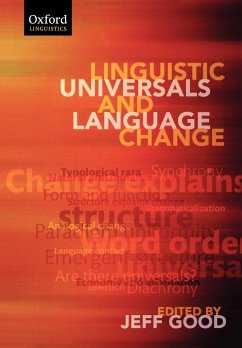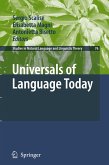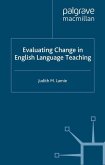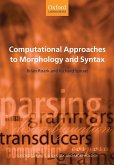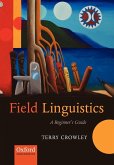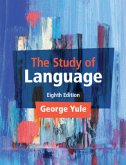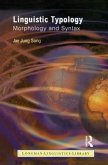Jeff Good
Linguistic Universals and Language Change (Paperback)
Jeff Good
Linguistic Universals and Language Change (Paperback)
- Broschiertes Buch
- Merkliste
- Auf die Merkliste
- Bewerten Bewerten
- Teilen
- Produkt teilen
- Produkterinnerung
- Produkterinnerung
In this book leading scholars examine and assess rival explanations for linguistic universals and the effectiveness of different models of language change. They illustrate their arguments with a very wide range of reference to the world's languages.
Andere Kunden interessierten sich auch für
![Universals of Language Today Universals of Language Today]() Universals of Language Today154,99 €
Universals of Language Today154,99 €![Evaluating Change in English Language Teaching Evaluating Change in English Language Teaching]() J. LamieEvaluating Change in English Language Teaching39,99 €
J. LamieEvaluating Change in English Language Teaching39,99 €![Knowledge and Learning in Natural Language Knowledge and Learning in Natural Language]() Charles D. YangKnowledge and Learning in Natural Language69,99 €
Charles D. YangKnowledge and Learning in Natural Language69,99 €![Computational Approaches to Morphology and Syntax Computational Approaches to Morphology and Syntax]() Brian RoarkComputational Approaches to Morphology and Syntax72,99 €
Brian RoarkComputational Approaches to Morphology and Syntax72,99 €![Field Linguistics Field Linguistics]() Terry CrowleyField Linguistics52,99 €
Terry CrowleyField Linguistics52,99 €![The Study of Language The Study of Language]() George YuleThe Study of Language33,99 €
George YuleThe Study of Language33,99 €![Linguistic Typology Linguistic Typology]() Jae Jung SongLinguistic Typology85,99 €
Jae Jung SongLinguistic Typology85,99 €-
-
In this book leading scholars examine and assess rival explanations for linguistic universals and the effectiveness of different models of language change. They illustrate their arguments with a very wide range of reference to the world's languages.
Hinweis: Dieser Artikel kann nur an eine deutsche Lieferadresse ausgeliefert werden.
Hinweis: Dieser Artikel kann nur an eine deutsche Lieferadresse ausgeliefert werden.
Produktdetails
- Produktdetails
- Verlag: OUP Oxford
- Seitenzahl: 356
- Erscheinungstermin: 15. März 2001
- Englisch
- Abmessung: 244mm x 170mm x 19mm
- Gewicht: 615g
- ISBN-13: 9780199228997
- ISBN-10: 019922899X
- Artikelnr.: 23406010
- Herstellerkennzeichnung
- Libri GmbH
- Europaallee 1
- 36244 Bad Hersfeld
- gpsr@libri.de
- Verlag: OUP Oxford
- Seitenzahl: 356
- Erscheinungstermin: 15. März 2001
- Englisch
- Abmessung: 244mm x 170mm x 19mm
- Gewicht: 615g
- ISBN-13: 9780199228997
- ISBN-10: 019922899X
- Artikelnr.: 23406010
- Herstellerkennzeichnung
- Libri GmbH
- Europaallee 1
- 36244 Bad Hersfeld
- gpsr@libri.de
Jeff Good is Assistant Professor in the Department of Linguistics at the University at Buffalo. He was previously a senior research fellow at the Max Planck Institute for Evolutionary Anthropology in Leipzig. He has examined the relationship between grammatical patterns and language change in diverse languages, including Chechen, Saramaccan, Turkish, and languages of the Bantu family. His published work includes articles in Diachronica, Studies in Language, Lingua, and the Yearbook of Morphology.
* 1: Jeff Good: Introduction
* Part I Universals and Change: General Perspectives
* 2: Paul Kiparsky: Universals Constrain Change; Change Results in
Typological Generalizations
* 3: Alice C. Harris: On the Explanation of Typologically Unusual
Structures
* Part II Phonological Universals: Variation, Change, and Structure
* 4: Juliette Blevins: Consonant Epenthesis: Natural and Unnatural
Histories
* 5: Joan L. Bybee: Formal Universals as Emergent Phenomena: The
Origins of Structure Preservation
* Part III Morphological Relationships: The Shape of Paradigms
* 6: Andrew Garrett: Paradigmatic Uniformity and Markedness
* 7: Adam Albright: Explaining Universal Tendencies and Language
Particulars in Analogical Change
* Part IV Morphosyntactic Patterns: The Form of Grammatical Markers
* 8: Martin Haspelmath: Creating Economical Morphosyntactic Patterns in
Language Change
* 9: Tania Kuteva and Bernd Heine: On the Explanatory Value of
Grammaticalization
* Part V Phrase Structure: Modelling the Development of Syntactic
Constructions
* 10: John Whitman: The Classification of Constituent Order
Generalizations and Diachronic Explanation
* 11: Paul J. Hopper: Emergent Serialization in English: Pragmatics and
Typology
* Part VI Conclusion
* 12: Johanna Nichols: Universals and Diachrony: Some Observations
* References
* Index
* Part I Universals and Change: General Perspectives
* 2: Paul Kiparsky: Universals Constrain Change; Change Results in
Typological Generalizations
* 3: Alice C. Harris: On the Explanation of Typologically Unusual
Structures
* Part II Phonological Universals: Variation, Change, and Structure
* 4: Juliette Blevins: Consonant Epenthesis: Natural and Unnatural
Histories
* 5: Joan L. Bybee: Formal Universals as Emergent Phenomena: The
Origins of Structure Preservation
* Part III Morphological Relationships: The Shape of Paradigms
* 6: Andrew Garrett: Paradigmatic Uniformity and Markedness
* 7: Adam Albright: Explaining Universal Tendencies and Language
Particulars in Analogical Change
* Part IV Morphosyntactic Patterns: The Form of Grammatical Markers
* 8: Martin Haspelmath: Creating Economical Morphosyntactic Patterns in
Language Change
* 9: Tania Kuteva and Bernd Heine: On the Explanatory Value of
Grammaticalization
* Part V Phrase Structure: Modelling the Development of Syntactic
Constructions
* 10: John Whitman: The Classification of Constituent Order
Generalizations and Diachronic Explanation
* 11: Paul J. Hopper: Emergent Serialization in English: Pragmatics and
Typology
* Part VI Conclusion
* 12: Johanna Nichols: Universals and Diachrony: Some Observations
* References
* Index
* 1: Jeff Good: Introduction
* Part I Universals and Change: General Perspectives
* 2: Paul Kiparsky: Universals Constrain Change; Change Results in
Typological Generalizations
* 3: Alice C. Harris: On the Explanation of Typologically Unusual
Structures
* Part II Phonological Universals: Variation, Change, and Structure
* 4: Juliette Blevins: Consonant Epenthesis: Natural and Unnatural
Histories
* 5: Joan L. Bybee: Formal Universals as Emergent Phenomena: The
Origins of Structure Preservation
* Part III Morphological Relationships: The Shape of Paradigms
* 6: Andrew Garrett: Paradigmatic Uniformity and Markedness
* 7: Adam Albright: Explaining Universal Tendencies and Language
Particulars in Analogical Change
* Part IV Morphosyntactic Patterns: The Form of Grammatical Markers
* 8: Martin Haspelmath: Creating Economical Morphosyntactic Patterns in
Language Change
* 9: Tania Kuteva and Bernd Heine: On the Explanatory Value of
Grammaticalization
* Part V Phrase Structure: Modelling the Development of Syntactic
Constructions
* 10: John Whitman: The Classification of Constituent Order
Generalizations and Diachronic Explanation
* 11: Paul J. Hopper: Emergent Serialization in English: Pragmatics and
Typology
* Part VI Conclusion
* 12: Johanna Nichols: Universals and Diachrony: Some Observations
* References
* Index
* Part I Universals and Change: General Perspectives
* 2: Paul Kiparsky: Universals Constrain Change; Change Results in
Typological Generalizations
* 3: Alice C. Harris: On the Explanation of Typologically Unusual
Structures
* Part II Phonological Universals: Variation, Change, and Structure
* 4: Juliette Blevins: Consonant Epenthesis: Natural and Unnatural
Histories
* 5: Joan L. Bybee: Formal Universals as Emergent Phenomena: The
Origins of Structure Preservation
* Part III Morphological Relationships: The Shape of Paradigms
* 6: Andrew Garrett: Paradigmatic Uniformity and Markedness
* 7: Adam Albright: Explaining Universal Tendencies and Language
Particulars in Analogical Change
* Part IV Morphosyntactic Patterns: The Form of Grammatical Markers
* 8: Martin Haspelmath: Creating Economical Morphosyntactic Patterns in
Language Change
* 9: Tania Kuteva and Bernd Heine: On the Explanatory Value of
Grammaticalization
* Part V Phrase Structure: Modelling the Development of Syntactic
Constructions
* 10: John Whitman: The Classification of Constituent Order
Generalizations and Diachronic Explanation
* 11: Paul J. Hopper: Emergent Serialization in English: Pragmatics and
Typology
* Part VI Conclusion
* 12: Johanna Nichols: Universals and Diachrony: Some Observations
* References
* Index

